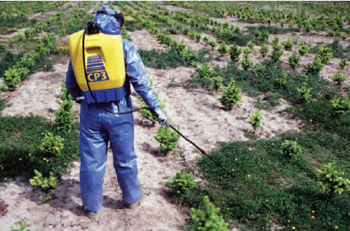Content
This subject is described in detail in machinery texts. However, certain
basic principles related to the covering of the leaf and soil by sprays
will be mentioned. The application of liquids and wettable powders by
means of sprayers may be adjusted in terms of pressure and nozzle type
to provide the required spray rate. Cone nozzles produce a turbulent
spray pattern suitable for fungicide and insecticide use, while fan
nozzles produce a flat spray pattern for herbicide application. In periods
of active plant growth fortnightly sprays may be
necessary to control
pests and diseases on newly expanding foliage.
 |
Figure 16.10 Knapsack sprayer being used in
nursery stock |
- High volume sprayers apply the diluted chemical at rates of
600–1000 l/ha in order to cover the whole
leaf surface with droplets
of 0.04–0.10 mm diameter. Cover of the under-leaf surface with
pesticides may be poor if nozzles are not directed horizontally or
upwards. Soil applied chemicals, such as herbicides or drenches, may
be sprayed at a larger droplet size, 0.25–0.5 mm in diameter, through a
selected fan nozzle. The correct height of the sprayer boom above the
plant is essential for downward-directed nozzles if the spray pattern
is to be evenly distributed. Savings can be achieved by band spraying
herbicides in narrow strips over the crop to leave the inter-row for
mechanical cultivation.
- Medium volume (200–600 l/ha) and low volume (50–200 l/ha)
equipment, such as knapsack sprayers, apply herbicides and pesticides
onto the leaf at a lower droplet density, and in tree crops, mist blower
equipment creates turbulence, and therefore increased spray travel,
by means of a power driven fan. Ultra-low volume sprays (up to
50 l/ha) are dispersed on leaving the sprayer by a rapidly rotating disc
which then throws regular-sized droplets into the air. Larger droplets
(about 0.2 mm) are created by herbicide sprayers to prevent spraydrift
problems, while smaller droplets (about 0.1 mm) allow good
penetration and leaf cover for insecticide and fungicide use.
Fogging machines used in greenhouses and stores produce very
fine droplets (about 0.015 mm diameter) by thermal and mechanical
methods, and use small volumes of concentrated formulation (less than
1 l in 400 m 3 ) which act as fumigants in the air, and as contact pesticides
when deposited on the leaf surface. Dust and granule applicators spread the formulations evenly over the foliage or ground surface.
When mounted on seed drills and/or fertilizer applicators, granules
may be incorporated into the soil. Care must be taken to ensure good
distribution to prevent pesticide damage to germinating seeds or planting
material.
Safe practice
In chemical control, the hazards are:
- possible acute poisoning of humans, pets, farm animals, bees, and
wild animals;
- possible accumulation of pesticides that lead to toxic levels in
humans, pets, farm animals, bees and wild animals;
- possible cancer inducing effects in humans;
- possible damage to cultivated and wild plants especially by
herbicides;
- possible contamination of streams and dams;
- possible development of strains of rodents, insects, mites, and fungi,
resistant to pesticides.
When using chemical control, risks can be minimized by:
- restricting chemical applications to only those situations that justify
such a control measure. In many instances, other controls measures
may be preferable and less hazardous;
- carefully choosing the least hazardous chemical to effectively control
the problem organism;
- carefully reading the instructions on the product label;
- carefully choosing the correct clothing, where necessary;
- carefully measuring the correct amount of concentrate water (where
relevant);
- calculating (where appropriate) the amount of pesticide and water
necessary for application to the crop area in question;
- carefully mixing the two, avoiding spillage on to skin, clothing and
the surrounding area;
- carefully applying the product so that the same area is not covered
more than once, at any one time;
- carefully applying the product under suitable dry, wind-free weather
conditions;
- carefully applying the product so that other humans, beneficial
animals, waterways and adjacent plantings are avoided;
- carefully avoiding spray drift, especially with herbicides;
- carefully storing pesticides in a secure, safe, dry place away from
children and pets.
|





